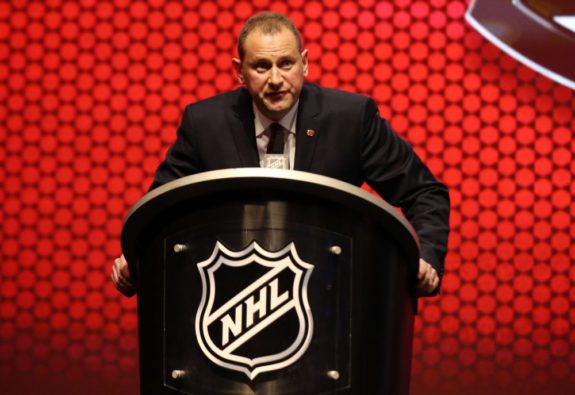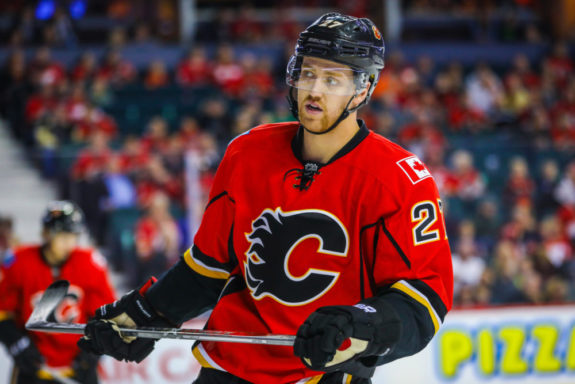The Calgary Flames came into the 2017-18 National Hockey League season with lofty goals and big expectations. They hoped to take a step forward after making the 2017 Stanley Cup playoffs as a wild-card team. They hoped to make a push towards the 100 point mark in the standings. They loaded up over the summer, acquiring Mike Smith and Travis Hamonic and re-signing Michael Stone at the cost of several picks in the 2018 NHL Draft.

But despite all these investments and several improvements, the Flames will likely end the season in the least enviable position of all: the NHL’s “no man’s land” in-between the last playoff spots and the lottery picks. And with no first round selection this year, even that wouldn’t have provided them with any consolation. They’re truly facing the worst of both worlds.
Several Improvements Made
On many levels, the Flames are a significantly better hockey club than they were a year ago.
They have the puck more. After 70 games, they were third in the NHL at puck possession by percentage with a 53.2% Corsi For, behind only Carolina and Boston. That’s a big improvement over their 50.5% Corsi For last season, which placed them 10th overall. On a per-60-minutes basis, their offensive jumped from 54.15 events generated per 60 to 66.14 while their defense also jumped from 53.01 events allowed per 60 to 58.21. (All numbers cited here are courtesy Natural Stat Trick.)
Handicapping the wild Western Conference playoff race: looking at the underlying trends behind the six teams still in the hunt. https://t.co/WDB5jahwsn pic.twitter.com/pi80Q3N3A2
— dom 📈 (@domluszczyszyn) March 14, 2018
They’re doing more with the puck. The Flames have made improvements at generating chances, both “regular” scoring chances and dangerous scoring chances. They’re third in scoring chance percentage (behind Boston and Carolina) and third in high-danger chance percentage (behind Dallas and Minnes0ta). In years past, they’ve barely broken even with their chances, but this season they’ve broken through and really looked like a dangerous team on many occasions.
Several Challenges
Despite having the puck quite often and generating some dangerous opportunities with the puck, the Flames have faced a lot of challenges.
The Flames lead the NHL in missed shots, with roughly 75 more missed shots than the second-ranked team. These missed shots are reflected in their scoring chance and puck possession numbers, suggesting that they’re getting the puck into the dangerous areas of the ice… but then they’re just not burying their shots. This theory is supported by the team’s placement in the league’s bottom third in terms of shooting percentage – both at even strength and overall.

Their special teams have disappointed throughout the season. Their power play is ranked 24th, negating the work of their 13th-ranked penalty kill. Their few goals scored with the man advantage have been cancelled out by the opposition power play goals they’ve allowed, despite having the third-most power play time in the NHL. How can a power play that regularly features the likes of Johnny Gaudreau, Sean Monahan, Dougie Hamilton and Mark Giordano fail to score so often? Once again, the Flames miss the net a lot and, when they don’t, they often fire pucks right into the goaltender’s chest.
Overall, the Flames are a dangerous offensive team that can’t bury a lot of their chances, while occasionally having some issues with transitioning the puck out of their defensive zone. These traits have led to them being as top-heavy a team as they were during Bob Hartley’s tenure as head coach. If you can figure out a way to shut down Gaudreau’s top line and perhaps Mikael Backlund’s second unit, you’re well on your way to beating them.
The Road Ahead
The Flames are in a spot that must frustrate the team’s coaching staff and management. There are inevitably some moves coming this summer, regardless of whether or not they can eke into the playoffs – they probably will try to recoup some draft picks, otherwise they don’t select until the middle of the fourth round if they miss the postseason. But hopefully general manager Brad Treliving doesn’t throw out the proverbial baby out with the bathwater. The Flames have a young core with rapidly improving players, most of which are signed for the long haul at manageable salaries. Emotions will definitely be running high if the Flames’ season meets a disappointing end, but the path to future success requires their management team to let things settle a bit before they start making moves.